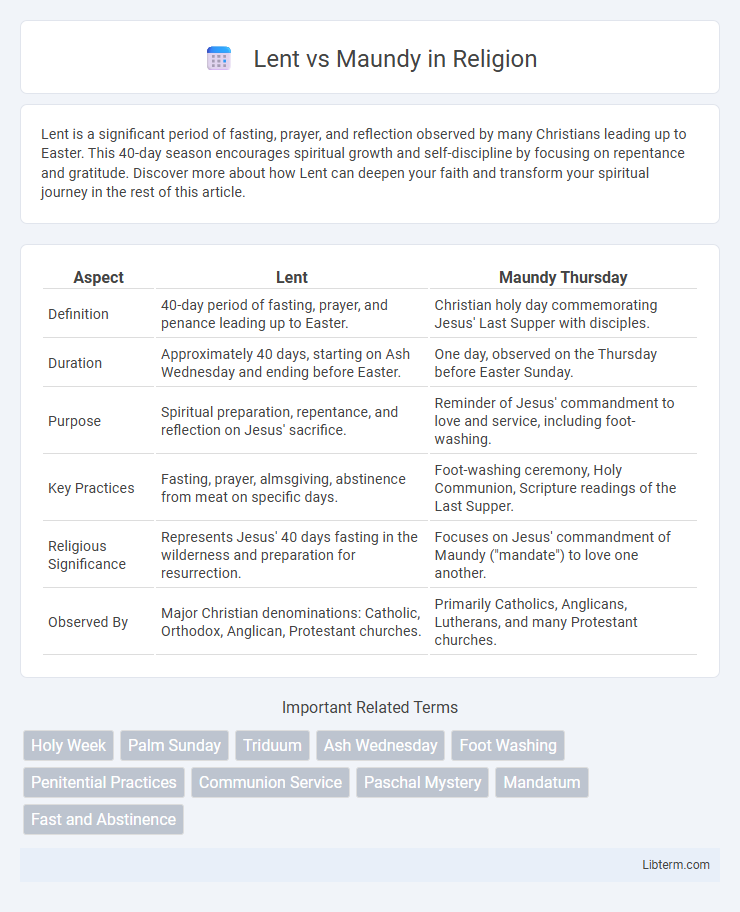Lent is a significant period of fasting, prayer, and reflection observed by many Christians leading up to Easter. This 40-day season encourages spiritual growth and self-discipline by focusing on repentance and gratitude. Discover more about how Lent can deepen your faith and transform your spiritual journey in the rest of this article.
Table of Comparison
| Aspect | Lent | Maundy Thursday |
|---|---|---|
| Definition | 40-day period of fasting, prayer, and penance leading up to Easter. | Christian holy day commemorating Jesus' Last Supper with disciples. |
| Duration | Approximately 40 days, starting on Ash Wednesday and ending before Easter. | One day, observed on the Thursday before Easter Sunday. |
| Purpose | Spiritual preparation, repentance, and reflection on Jesus' sacrifice. | Reminder of Jesus' commandment to love and service, including foot-washing. |
| Key Practices | Fasting, prayer, almsgiving, abstinence from meat on specific days. | Foot-washing ceremony, Holy Communion, Scripture readings of the Last Supper. |
| Religious Significance | Represents Jesus' 40 days fasting in the wilderness and preparation for resurrection. | Focuses on Jesus' commandment of Maundy ("mandate") to love one another. |
| Observed By | Major Christian denominations: Catholic, Orthodox, Anglican, Protestant churches. | Primarily Catholics, Anglicans, Lutherans, and many Protestant churches. |
Understanding Lent: A Brief Overview
Lent is a 40-day period of fasting, prayer, and reflection observed by Christians to prepare for Easter, symbolizing Jesus Christ's 40 days in the desert. Maundy Thursday, falling within Lent, commemorates the Last Supper and Jesus' commandment to love one another. Understanding Lent involves recognizing its spiritual significance and its role in deepening faith through penance and renewal.
What is Maundy? Origins and Meaning
Maundy, derived from the Latin word "mandatum" meaning "commandment," refers to the Christian observance on Holy Thursday commemorating Jesus Christ's command to his disciples to love one another, symbolized by the washing of feet. Originating from the Last Supper narratives in the Gospels, Maundy Thursday rituals emphasize humility, service, and renewal of faith among believers. This tradition highlights the transition from the penitential season of Lent to the solemn events of Easter, marking Jesus' preparation for his passion and resurrection.
Historical Roots: Lent and Maundy in Christian Tradition
Lent traces its origins to early Christian practices of fasting and repentance lasting 40 days, symbolizing Jesus Christ's time in the wilderness as described in the Gospels of Matthew, Mark, and Luke. Maundy Thursday commemorates the Last Supper and Jesus' commandment of love ("mandatum" in Latin), rooted in the Gospel of John, highlighting the institution of the Eucharist and the ritual of foot washing. Both periods hold deep historical significance within Christian liturgical traditions, reflecting themes of sacrifice, service, and preparation for Easter.
Key Differences Between Lent and Maundy
Lent is a 40-day period of fasting, prayer, and penance observed by Christians leading up to Easter, emphasizing repentance and spiritual renewal. Maundy, specifically Maundy Thursday, commemorates the Last Supper of Jesus Christ with his disciples, highlighting themes of service and humility through the ritual of washing feet. While Lent covers an extended season with broad spiritual practices, Maundy Thursday focuses on a singular event within Holy Week with specific liturgical traditions.
Significance of Lent in Christian Practice
Lent represents a solemn 40-day period in Christian practice dedicated to fasting, prayer, and repentance, symbolizing Jesus Christ's 40 days in the wilderness. This season helps believers prepare spiritually for Easter by encouraging self-discipline and reflection on sin and redemption. Maundy Thursday, occurring during Holy Week, commemorates the Last Supper but lacks the extended period of preparation that defines Lent's significance in fostering spiritual growth.
The Importance of Maundy Thursday
Maundy Thursday holds significant importance as it commemorates the Last Supper, where Jesus instituted the Eucharist and washed the disciples' feet, symbolizing humility and service. This day marks the beginning of the Easter Triduum and emphasizes the themes of sacrifice and love central to Christian faith. Observing Maundy Thursday deepens believers' reflection on Jesus' final acts before his crucifixion and the foundation of Holy Communion.
Rituals and Observances: Lent vs Maundy
Lent is a 40-day period of fasting, prayer, and almsgiving observed by Christians to prepare for Easter through rituals such as Ash Wednesday services, fasting on Fridays, and Stations of the Cross. Maundy Thursday commemorates the Last Supper with rituals including the washing of feet, Holy Communion, and the stripping of the altar to symbolize humility and service. While Lent emphasizes penitence and spiritual discipline, Maundy Thursday focuses on remembrance of Jesus' commandment to love and serve others.
Spiritual Themes: Reflection, Repentance, and Service
Lent emphasizes reflection and repentance through a 40-day period of fasting, prayer, and self-examination, preparing believers for spiritual renewal. Maundy Thursday highlights service by commemorating Jesus' command to love and serve others, demonstrated through the washing of disciples' feet. Together, they embody a journey of humility, sacrifice, and commitment to living a Christ-centered life.
Lent and Maundy in Modern Christianity
Lent in modern Christianity is a 40-day period of fasting, prayer, and reflection observed to prepare believers for Easter, emphasizing repentance and spiritual renewal. Maundy Thursday commemorates Jesus' Last Supper with his disciples, highlighting themes of humility and service through the ritual of foot-washing and the institution of the Eucharist. These observances reinforce core Christian values and liturgical practices, shaping the faith experience during Holy Week.
FAQs: Clarifying Common Misconceptions
Lent is a 40-day period of fasting, prayer, and reflection observed by many Christians leading up to Easter, while Maundy Thursday commemorates the Last Supper of Jesus Christ with his disciples. Frequently asked questions often confuse these events, such as whether Maundy Thursday is part of Lent or a separate observance; in fact, Maundy Thursday occurs during Holy Week, which follows the conclusion of Lent. Clarifying these distinctions helps believers understand the unique spiritual significance of Lent's preparatory season and Maundy Thursday's celebration of Jesus' commandment of love.
Lent Infographic

 libterm.com
libterm.com